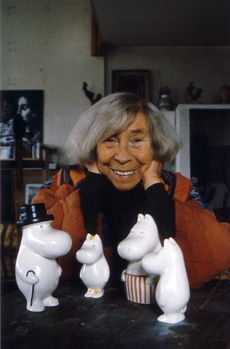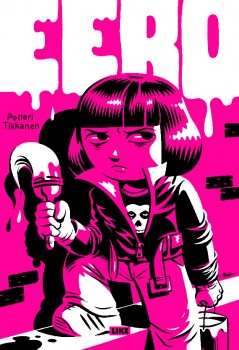Search results for "2010/05/2009/10/2011/04/matti-suurpaa-parnasso-1951–2011-parnasso-1951–2011"
Annika Luther: De hemlösas stad [The city of the homeless]
17 January 2012 | Mini reviews, Reviews
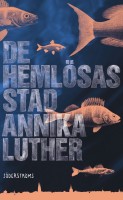 De hemlösas stad
De hemlösas stad
[The city of the homeless]
Helsingfors: Söderströms, 2011. 237 p.
ISBN 978-951-522-846-8
€ 21.10, paperback
Kodittomien kaupunki
Suomennos [Translation from Swedish into Finnish]: Asko Sahlberg
Helsinki: Teos, 2011. 240 p.
ISBN 978-951-851-404-9
€ 33.10, paperback
Annika Luther’s novel is an example of the popular genre of dystopia. Its ecocritical overtones prompt radically new ways of thinking about the effects of climate change. In 2050, the bulk of the earth’s surface is under water, and people from various corners of the earth have been evacuated to Finland. The majority of the residents in Helsinki are Indian and Chinese. Finns are in the minority, and most of them are hopelessly addicted to alcohol. Fifteen-year-old Lilja lives in the city of Jyväskylä with her family, in a protected and tightly controlled neighbourhood. She becomes interested in her family history and decides to find out about her aunt, a marine biologist who remained in flooded Helsinki. Gradually, the mysteries of the past open up to her. The novel is about survival and adaptation. Luther is an original writer, uncompromising in her ethical stance. As in her previous novel, Ivoria (2009), she describes Helsinki with affection: despite the ruined landscape, the city maintains its proud bearing.
Translated by Fleur Jeremiah and Emily Jeremiah
Make or break?
17 November 2011 | This 'n' that
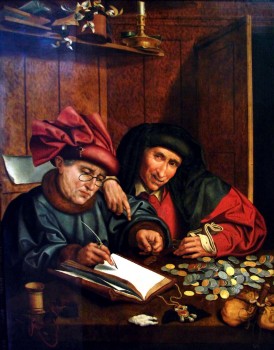
Two tax collectors: anonymous painter, after Marinus van Reymerswaele (ca. 1575–1600). Musée des Beaux-Arts de Nancy. Wikimedia
In Finland, tax returns are public information. So, every November the media publish lists of the top earners in Finland, dividing them into the categories of earned and investment income. Every November it is revealed who are millionaires and who are just plain rich.
The Taloussanomat (‘The economic news’) newspaper offers a list (Finnish only) of the 5,000 people who earned most last year (in terms of both earned and investment income, together with the proportion of income they have paid in tax). You can also search lists of various status and professions: rock/pop stars, media, sports, MPs, celebrities, politicians of various political parties…
So let’s take a look at Taloussanomat’s selected list of authors: number one is the celebrity author Jari Tervo (309,971 euros, tax percentage 45); number two, the internationally famous Sofi Oksanen (302,634 euros, 46 per cent); the next two are Sinikka Nopola, writer of children’s books, (264,000) and Arto Paasilinna (262,300; now after an illness, retired as a writer), translated into more than 30 languages since the 1970s. (The film critic and author Peter von Bagh made almost 900,000 euros – not by writing books, but by selling his share of a music company to an international enterprise.)
As tax data are public in Finland, there’s vigorous and decidedly informed public debate on how much money, for example, directors of public pension institutions and government offices or ministers and other top politicians are paid, and how much they should be paid: what is equitable, what is reasonable? A million dollar question indeed…
Among the European Union countries, it is only in Finland, Sweden and Denmark that there is no universal minimum wage. Here, wages are determined in trade wage negotiations. The average monthly salary in the private sector in 2010 was approximately 3,200 euros. In contrast to that, Olli-Pekka Kallasvuo, the Nokia CEO and President, who tops the 2010 tax list, earned a salary of 8 million last year, because – and precisely because – he was sacked (and replaced by the Irishman Steven Elop).
The CIA’s Gini index measures the degree of inequality in the distribution of family income in a country. The more unequal a country’s income distribution, the higher is its Gini index. The country with the highest number is Sweden, 23; the lowest, South Africa, 65 (data from both, 2005). Finland’s figure is 26.8 (2008), Germany 27 (2006), the European Union’s 34. The United Kingdom stands at 34 (2005), and the USA at 45 (2007). The figure in Finland seems to be on the rise though, as the figure back in 1991 was 25.6.
There’s been plenty of research and debate on economic inequality and the ways it harms societies. This link takes you to a fascinating video lecture (July 2011 – now seen by almost half a million people) by Richard Wilkinson, British author, Profefssor Emeritus of social epidemiology.
Hip hip hurray, Moomins!
22 October 2010 | This 'n' that
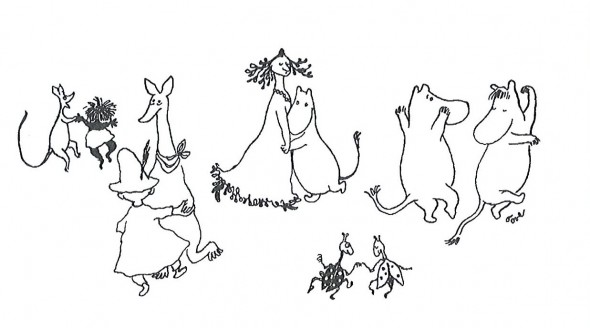
Partying in Moomin Valley: Moomintroll (second from right) dancing through the night with the Snork Maiden (from Tove Jansson’s second Moomin book, Kometjakten, Comet in Moominland, 1946)
The Moomins, those sympathetic, rotund white creatures, and their friends in Moomin Valley celebrate their 65th birthday in 2010.
Tove Jansson published her first illustrated Moomin book, Småtrollen och den stora översvämningen (‘The little trolls and the big flood’) in 1945. In the 1950s the inhabitants of Moomin Valley became increasingly popular both in Finland and abroad, and translations began to appear – as did the first Moomin merchandise in the shops.
Jansson later confessed that she eventually had begun to hate her troll – but luckily she managed to revise her writing, and the Moomin books became more serious and philosophical, yet retaining their delicious humour and mild anarchism. The last of the nine storybooks, Moominvalley in November, appeared in 1970, after which Jansson wrote novels and short stories for adults.
Tove Jansson (1914–2001) was a painter, caricaturist, comic strip artist, illustrator and author of books for both children and adults. Her Moomin comic strips were published in the daily paper the London Evening News between 1954 and 1974; from 1960 onwards the strips were written and illustrated by Tove’s brother Lars Jansson (1926–2000).
Tove’s niece, Sophia Jansson (born 1962) now runs Moomin Characters Ltd as its artistic director and majority shareholder. (The company’s latest turnover was 3,6 million euros).
For the ever-growing fandom of Jansson there is a delightful biography of Tove (click ‘English’) and her family on the site, complete with pictures, video clips and texts.
The world now knows Moomins; the books have been translated into 40 languages. The London Children’s Film Festival in October 2010 featured the film Moomins and the Comet Chase in 3D, with a soundtrack by the Icelandic artist Björk. An exhibition celebrating 65 years of the Moomins (from 23 October to 15 January 2011) at the Bury Art Gallery in Greater Manchester presented Jansson’s illustrations of Moominvalley and its inhabitants.
In association with several commercial partners in the Nordic countries Moomin Characters launched a year-long campaign collecting funds to be donated to the World Wildlife Foundation for the protection of the Baltic Sea. Tove Jansson lived by the Baltic all her life – she spent most of her summers on a small barren island called Klovharu – and the sea featured strongly in her books for both children and adults.
Comic prize
26 March 2010 | In the news
Sarjakuva-Finlandia, worth €5,000, is the name of a prize created in 2007 for Finnish graphic novels or comic books. (Sarjakuva, literally ‘serial picture’, refers to both comic strips and books as well as graphic novels.)
It is awarded annually at the Tampere comics festival (and has nothing to do with the Finlandia prizes for literature, awarded by the Finnish Book Foundation).
Out of 56 contestants, ten made it into the final run, and the winner, Eero, by Petteri Tikkanen, was chosen by the thriller writer Matti Rönkä.
Petteri Tikkanen (born 1975) is a graphic artist who has published several books. In his previous graphic novels about a girl named Kanerva, Eero has appeared as her friend. Now Eero is the central character, and it seems childhood is over. Kanerva likes to chill out with her girlfriends only – what is a boy to do?
Henrik Meinander: Kekkografia. Historiaesseitä [Kekkography. History essays]
1 April 2011 | Mini reviews, Reviews
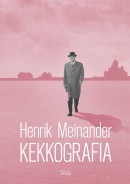 Kekkografia. Historiaesseitä
Kekkografia. Historiaesseitä
[Kekkography. History essays]
Suomentanut [Translated into Finnish from the original Swedish texts by] Matti Kinnunen
Helsinki: Siltala, 2010. 229 p.
ISBN 978-952-234-040-5
€ 34, hardback
Professor Henrik Meinander examines the forces that have shaped Finnish history and the controversial issues that have marked its development; Finnish history and culture were formed by chain reactions in European power politics. Finland did not emerge as a nation until the 19th century, as a by-product of the Napoleonic wars, and the independence of 1917 was not the result of an autonomous process of national development but rather a consequence of events elsewhere, especially in Russia. The history of independent Finland is roughly equal in length to that of the Soviet Union; in the early 1990s the Soviet Union collapsed, and Finland joined the European Union. The author does not take a position on the desirability of this development, and points out that the increasing integration and globalisation Finland’s era of independence may appear to be only a transitory phase. President Urho Kekkonen (1900–1986), who influenced Finnish politics for half a century and whose name gives the work its title, figures in approximately half of the texts.
Translated by David McDuff
Grim(m) stories?
30 April 2010 | Letter from the Editors
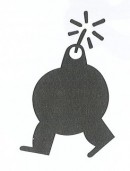 ‘There’s not been much wit and not much joy, there’s a lot of grimness out there.’
‘There’s not been much wit and not much joy, there’s a lot of grimness out there.’
This comment on new fiction could have been presented by anyone who’s been reading new Finnish novels or short stories. The commentator was, however, the 2010 British Orange Prize judge Daisy Goodwin, who in March complained about the miserabilist tendencies in new English-language women’s writing. More…
Utopia or cacotopia?
19 August 2011 | Extracts, Non-fiction
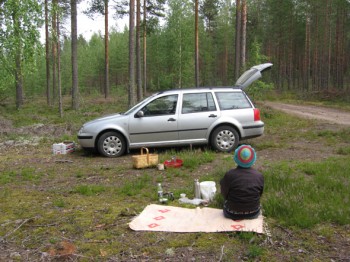
Viljakansaari, Finland, 2008. ©Merja Salo
Do we live in the age of autopia, and if we do, what does that mean? On this earth there are now perhaps 800 million cars, all vital to our modern lifestyles. Professor and photographer Merja Salo observes landscapes through her camera with this question in mind
Extracts and photographs from Carscapes. Automaisemia (Edition Patrick Frey & Musta Taide, 2011. Translation: Laura Mänki)
The car may be the vehicle for the everyman, but not every man is a good driver. According to Hungarian- born psychoanalyst Michael Balint, good drivers have the psychological structure of philobats. With their sense of sight, they perceive space well and control it by steering their vehicle skilfully. Ocnophiles, on the other hand, are more at home as passengers. They structure the world through intimacy and touch. When driving, they cling anxiously to the steering wheel and do not perceive the continously changing situations in traffic.
Ulla Jokisalo & Anna Kortelainen
Pins and needles
11 May 2011 | Essays, Non-fiction
In these pictures by Ulla Jokisalo and texts by Anna Kortelainen, truths and mysteries concerning play are entwined with pictures painted with threads and needles. Jokisalo’s exhibition, ‘Leikin varjo / Guises of play’, runs at the Museum of Photography, Helsinki, from 17 August to 25 September.
Words and images from the book Leikin varjo / Guises of play (Aboa Vetus & Ars Nova and Musta Taide, 2011)
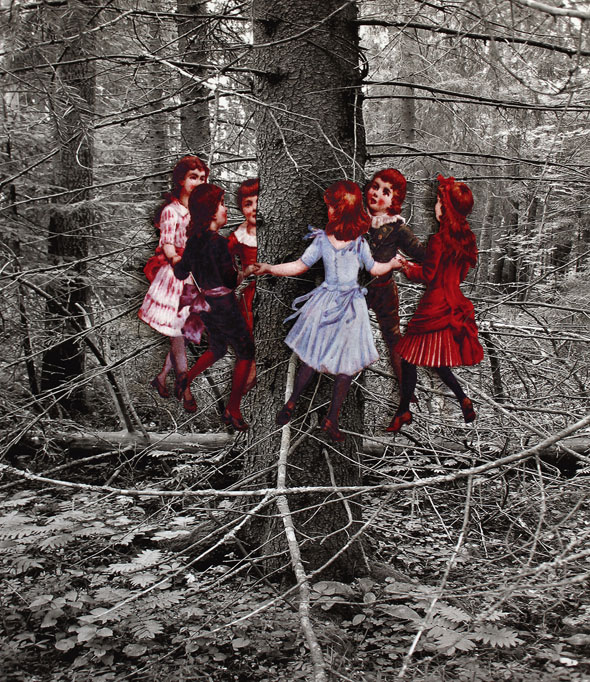
‘Ring dance’ by Ulla Jokisalo (pigment print and pins, 2009)
Finland, cool! The Frankfurt Book Fair 8–12 October
30 September 2014 | Articles, Non-fiction

Finnland. Cool. pavilion in Frankfurt, designed by Natalia Baczynska Kimberley, Nina Kosonen and Matti Mikkilä from Aalto University
It starts next week: Finland is Guest of Honour at the Book Fair in the German and global city of Frankfurt. This link will take you to it all.
Approximately 170,000 professionals from the literary world are expected to visit the exhibition halls from Wednesday to Friday; the weekend is reserved for the general public, c.100,000 visitors. Since 1980s different countries have been in focus each year. More…
In the detail?
11 December 2009 | Essays, Non-fiction
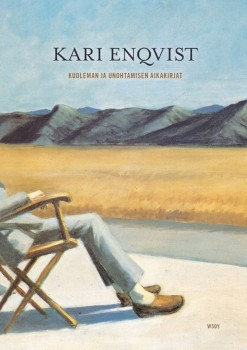 Extracts from Kuoleman ja unohtamisen aikakirjat (‘Chronicles of death and oblivion’, WSOY, 2009)
Extracts from Kuoleman ja unohtamisen aikakirjat (‘Chronicles of death and oblivion’, WSOY, 2009)
What’s the meaning of life? There are those who seek it in religion, while for others that is the last place to look. The scientist Kari Enqvist ponders why some people, including himself, seem physiologically immune to the lure of faith. Perhaps, he suggests, we should look for significance not in the big picture, but in the marvel of the fleeting moment
As a young boy I must have held religious beliefs. However, I cannot pinpoint exactly when they disappeared. At some point I eventually stopped saying my evening prayers, but I am unable to remember why or when this happened. ‘I was born in a time when the majority of young people had lost faith in God, for the same reason their elders had had it – without knowing why,’ writes the Portuguese poet Fernando Pessoa in The Book of Disquiet. More…
Jari Tervo: Koljatti [Goliath]
23 October 2009 | Mini reviews, Reviews
 Koljatti
Koljatti
[Goliath]
Helsinki: WSOY, 2009. 317 p.
ISBN 978-951-0-35610-4
25 €, hardback
Jari Tervo (born 1959) writes comic, swiftly paced, linguistically accomplished prose with touches of historicism, philosophy and social commentary. Koljatti is a contemporary satire that prompted a great deal of fuss in the Finnish press for its perceived nastiness: the similarities between its character Pekka Lahnanen, an isolated and beleaguered prime minister, and Matti Vanhanen, the current Finnish Prime Minister, are clear. This novel outlines some crude caricatures, but its critical barbs are aimed not at politics, but rather at the relationship between the media and politics. This book, which describes the events of a single fast-paced weekend, portrays politics as theatre, in which the only thing that matters is how things appear; the media will drop any substantive questions in their relentless pursuit of new sensationalist headlines of politicians’ private lives. The news may not look the same after reading this novel. Tervo is one of Finland’s most popular authors; three of his novels have appeared in translation, in four languages. [Read a short story here.]
Dear Reader!
13 January 2011 | This 'n' that
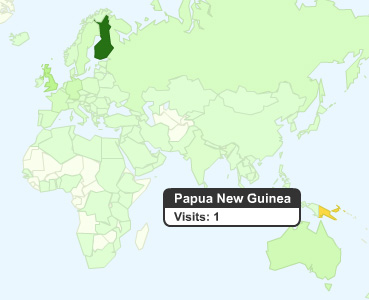
Reading Books from Finland here, there and... Photo: Google Analytics
2011 is well underway, and it’s back to business – reporting on good books from Finland, that is!
The new year also marks the beginning of our third year online: we are very pleased to note that last year visits to this site increased by 187 per cent compared to 2009!
Our foreign readers hail from a total of 149 countries, although the majority are in the United States and the United Kingdom – with a surprisingly large number of neighbourly visits from readers in Finland.
There are some countries where only one reader has taken a look at Books from Finland last year; greetings to our own readers in Honduras and Papua New Guinea…. But, on the other hand, readership in Belarus has grown by 2.400 per cent, from just one in 2009 to a grand total of 25!
We’ve been very glad to have your online feedback, which prompted us to think that since we haven’t done a reader survey for a longish time, we might take the opportunity to run another one now – so we’ll be quizzing you about your views of the contents of the journal on this page soon.
We hope to offer you more that is diverting, entertaining and thought-provoking this year than ever before. Remember, you can also keep abreast of what’s going on on the Books from Finland website by subscribing to our RSS and e-mail delivery services (and we’re on Facebook, too).
Happy new year, and good reading!
The editors
Soila Lehtonen (Helsinki)
Hildi Hawkins (London)
Beyond words
15 December 2010 | This 'n' that

Meeting place of the Lahti International Writers' Reunion: Messilä Manor
‘Whereof one cannot speak, thereof one must remain silent.’
This famous quotation from the Austrian philosopher Ludwig Wittgenstein has been adapted by the organisers of the Lahti International Writers’ Reunion (LIWRE): the theme of the 2011 Reunion, which takes place in June, will be ‘The writer beyond words’.
‘Whereof one cannot speak, thereof one must write.’ How will the writer meet the limits of language and narration?
‘There are things that will not let themselves be named, things that language can not reach. Our senses give us information that is not tied to language – how can it be translated into writing? And how is the writer going to describe horrors beyond understanding or ecstasy that escapes words? How can one put into words hidden memories, dreams and fantasies that lie suppressed in one’s mind? Does the writer fill holes in reality or make holes in something we only think is reality?
‘Besides literature, there are other forms of interpreting the world; can the writer step into their realms to find new ways of saying things? The surrounding social sphere may put its own limits to writing. What kind of language can a writer use in a world of censorship and stolen words? How does the writer relate to taboos, those dimensions of sexuality, death or holiness that the surrounding world would not want to see described at all? Is it the duty of literature to go everywhere and reveal everything, or is the writer a guardian of silence who does not reveal but protects secrets and everything that lies beyond language?’
The first Writers’ Reunion took place in Lahti at Mukkula Manor in 1963; since then, more than a thousand writers, translators, critics and other book people, both Finnish and foreign, have come to Mukkula to discuss various topics.
In 2009 the theme was ‘In other words’, which inspired the participants to talk about the power of the written word in strictly controlled regimes, about fiction that retells human history and about the differences between the language of men and women, among other things. See our report from the 2009 Reunion; eleven presentations are available in English, too.
Below and above the surface
13 March 2014 | Extracts, Non-fiction
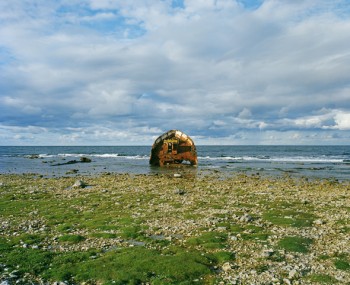
Fårö, Gotland, Sweden. Photo: Lauri Rotko
The Baltic Sea, surrounded by nine countries, is small, shallow – and polluted. The condition of the sea should concern every citizen on its shores. The photographers Jukka Rapo and Lauri Rotko set out in 2010 to record their views of the sea, resulting in the book See the Baltic Sea / Katso Itämerta (Musta Taide / Aalto ARTS Books, 2013). What is endangered can and must be protected, is their message; the photos have innumerable stories to tell
We packed our van for the first photo shooting trip in early May, 2010. The plan was to make a photography book about the Baltic Sea. We wanted to present the Baltic Sea free of old clichés.
No unspoiled scenic landscapes, cute marine animals, or praise for the bracing archipelago. We were looking for compelling pictures of a sea fallen ill from the actions of man. We were looking for honesty. More…
Helsinki: World Design Capital 2012
13 January 2012 | This 'n' that
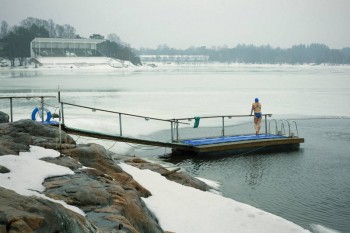
Swimming in the rain: winter joys of Helsinki. Photograph: Valtteri Hirvonen – Eriksson & Co.
After Turin (Italy, 2008) and Seoul (Republic of Korea, 2010), 2012 Helsinki is the third World Design Capital, selected in 2009 by the International Council of Societies of Industrial Design (ICSID).
Helsinki was considered to be a city where ‘design has for decades been a pivotal enabler to building an open city’.
The theme is ‘Open Helsinki – Embedding Design in Life‘. The idea is to improve the everyday life and environment of the citizens and the development of both public services and private enterprises.
In addition to Helsinki, the realisation of the Design Capital year will be carried out by four other cities: neighbouring Espoo, Vantaa and Kauniainen as well as Lahti (some hundred kilometres north of the capital). The Finnish government, two ministries, 21 commercial companies and some universities will co-operate in this project, which has a budget of 16 million euros (2010–2013).
The programme includes some 300 different events, half of them development projects, themed ‘The changing city’ or ‘New solutions’; the other half consists of various exhibitions and encounters for the citizens of Helsinki, tourists and design people.
The ultimate goal of this all is said to be ‘permanent change’. Whatever that really means – good luck!
However, as writer and design critic Kaj Kalin noted in a review in Helsingin Sanomat newspaper (30 December), Finland is full of well-educated designers, but lacks both investment money prepared to take risks and working industry: soon all production will have moved to cheaper countries – and nobody will be able to produce anything. New Finnish design, Kalin argues, mostly approximates merely to ‘a show parade of models and prototypes’.

